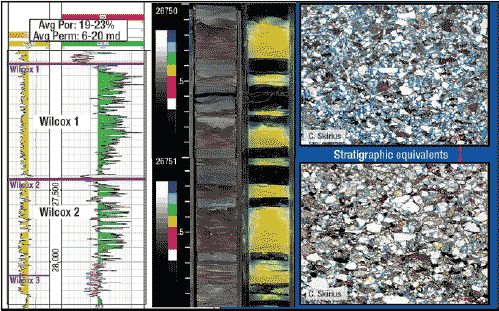What's new in exploration
The paradigm and the anomaly
The paradigm and the anomaly. The discovery of thick, sandy Wilcox-age strata in the most distal portions of the Gulf of Mexico Basin will produce a paradigm change. The deep Gulf of Mexico Wilcox play was the focus of the GCSSEPM Bob F. Perkins Research Conference. Excellent technical papers were presented describing the deepwater fan systems, petroleum resources, structural and tectonic style, trap types, chronostratigraphy and paleontology of the most exciting new play in North America, where recoverable reserves could be 3 to 15 Bbbl. From almost a full day of talks, however, I got the impression that it was always known that there were thick, sand-rich reservoirs in the deepest portions of the Gulf of Mexico Basin, but for some reason industry waited until 2000 to drill them. This is, of course, not the case. Those reservoirs were discovered accidentally while drilling large structures for Cretaceous objectives. A paradigm provides a conceptual framework to explain certain phenomena that would otherwise seem unrelated or incomprehensible. The existing paradigm for Gulf Coast Tertiary clastic deposition comprises the following elements:
Commercial oil was found in sandy Wilcox reservoirs that are thousands of feet thick in a broad belt that extends from the Alaminos Canyon to Walker Ridge OCS protraction areas. These sequences have been interpreted as submarine fans deposited on the Paleocene abyssal plain at least 250-300 mi from their coeval shelf margin. This represents a radical departure from the accepted GOM model, as well as from the overall paradigm for deepwater deposition. Josh Rosenfeld and I presented a hypothesis at the Perkins Conference that explained deposition of the deep Gulf Wilcox through sea-level fall caused by evaporation and slope bypassing (World Oil, June 2007; IHS Petroleum Frontiers, 2007). The GOM may have been isolated from the Atlantic Ocean when Cuba tectonically closed the 125-mi gap between the Florida-Bahamas and Yucatan blocks about 55 million years ago (Early to Middle Wilcox time). A sea-level fall of as much as 6,000 ft caused massive slope bypass, and the deepwater Wilcox was deposited largely by reworking and redeposition of previously deposited sediments. As sea level fell, a series of proximal, sandy basin-floor fans were progressively deposited.
At the end of our presentation, we received lively, engaged questions and comments from the audience for nearly an hour and continued to have spirited discussions with participants well into the evening. Our evidence and conclusions were naturally challenged but problems with the existing paradigm that require resolution were acknowledged. The need for paradigm change in the case of the deep GOM Wilcox is not an intellectual exercise, but has profoundly practical and commercial implications. The Chevron Jack-2 well flow test (Walker Ridge 759) included large hydraulic fracture stimulations, because the Wilcox reservoirs are thin-bedded and have low permeability (see figure). The 23-day test cost about $125 million in addition to $124 million to drill the well. Between 10 and 20 wells are anticipated to develop the Jack discovery at an estimated per-well cost of $150 million, and production facilities will cost an additional $1 billion. It is obviously critical to have a reservoir model that explains and anticipates more of the facts than the existing Gulf Coast Tertiary paradigm. Paradigms change because they never explain all of the facts. The presence of widespread, very thick Wilcox sands in the most distal portion of the Gulf is perhaps the greatest geological anomaly in this prolific and uniquely long-lived petroleum-producing basin. Furthermore, these Wilcox sands have no known analogue among modern or ancient examples of distal submarine fan deposits. It is ultimately unimportant if the drawdown explanation for Wilcox deposition presented at the Perkins Conference is accepted. It is important that the anomaly and the paradigm are reconciled in a way that not only moves science forward, but also optimizes the commercial development of vital, future petroleum resources.
|
|||||||||||
- Prices and governmental policies combine to stymie Canadian upstream growth (February 2024)
- U.S. producing gas wells increase despite low prices (February 2024)
- U.S. drilling: More of the same expected (February 2024)
- U.S. oil and natural gas production hits record highs (February 2024)
- Quantum computing and subsurface prediction (January 2024)
- U.S. upstream muddles along, with an eye toward 2024 (September 2023)





